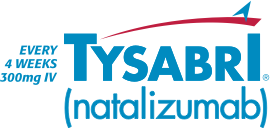QUALITY OF LIFE ANALYZED IN
PATIENTS TREATED WITH TYSABRI
TYSABRI can produce clinically meaningful improvements in mental and social health1
Study description: MS PATHS (Multiple Sclerosis Partners Advancing Technology and Health Solutions) is an ongoing initiative conducted in 10 healthcare institutions in 3 countries, each contributing standardized patient data during routine office visits from a large real-world cohort of MS patients.1,2 This analysis investigated the experiences reported by patients after starting natalizumab (n=164) using standard Quality of Life in Neurological Disorders (Neuro-QoL) assessments of 12 domains related to physical, mental, and social health.
- Data were collected at routine visits
- Patients completed the Neuro-QoL, a comprehensive, self-reported, computer-adaptive battery of assessments for 12 domains
- In the Neuro-QoL, standardized T-scores for each domain are derived from patient responses on a 5-point scale related to their feelings or functioning in the prior 7 days
- Analyses were also conducted in patients with impairment in Neuro-QoL domains at baseline, defined as a T-score of ≥55 for each of the negatively worded domains (sleep disturbance, emotional and behavioral dyscontrol, anxiety, depression, fatigue, stigma) or ≤45 for each of the positively worded domains
- The change in Neuro-QoL T-scores for each domain was assessed with a multivariate-adjusted mixed effects regression model
- The percentage of patients with ≥5-point improvement or worsening in T-scores was calculated from the last available Neuro-QoL
Study limitations:
- This is a real-world study that lacks randomization, and the results thus may be impacted by unconsidered variables or incomplete adjustment
- The standard cutoff of 5 points or half of standard deviation was used to establish minimal clinically important difference. The cutoff was based on the estimated effect size from several studies that included a mixed population of patients with diverse chronic diseases as well as some patients with MS
>75% of patients in the overall population improved or remained stable across each
of the assessed domains
CLINICALLY MEANINGFUL CHANGE IN NEURO-QoL T-SCORES
(OVERALL POPULATION)1
- 89% of patients improved or remained stable on the positive affect and well-being domain
- 85% of patients improved or remained stable on the cognitive function domain
- 84% of patients improved or remained stable on the fatigue domain
≥89% of patients with baseline impairment improved or remained stable across each
of the assessed domains
CLINICALLY MEANINGFUL CHANGE IN NEURO-QoL T-SCORES
(BASELINE IMPAIRMENT POPULATION)1
- 100% of patients improved or remained stable on the positive affect and well-being domain
- 89% of patients improved or remained stable on the cognitive function domain
- 94% of patients improved or remained stable on the fatigue domain
